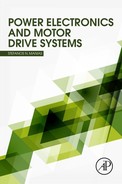12
Introduction to Motor Drive Systems
Abstract
This chapter deals with dc and ac motor drive systems. The operation and characteristics of the dc motor, induction motor, permanent magnet motor, and switched reluctance motor are examined first. Typical power electronics topologies and control techniques used in dc and ac motor drives are then presented and explained. The ac motor control techniques discussed in this chapter include scalar control, direct torque and flux control, direct self control, rotor field-oriented control, indirect field–oriented control, and flux vector modulation. Solved problems are presented to help the reader understand the theory presented in this chapter.
Keywords
Ac motor drive; Dc motor drive; Direct self control (DSC); Direct torque and flux control (DTC); Dynamic breaking; Electric motor drive system; Flux vector modulation (FVM); Indirect field–oriented control (IFOC); Mechanical load; Park and Clarke transformations; Permanent magnet motor drive; Power flow; Quadrants of operation; Regenerative breaking; Rotor field-oriented control (FOC); Scalar control; Simulation; Switched reluctance motor; Torque–speed characteristics; Vector dynamic electrical equivalent models
12.0. Introduction
A motor drive is a system that provides to a mechanical load with continuous range process speed and torque control (as compared to discrete speed control as in gear boxes or multispeed motors). A motor drive system is capable of adjusting both speed and torque of a dc or an ac motor. Motor drive systems are one of the most important and most interesting fields in electrical and power electronics engineering. The above description is clear if one considers the crucial role played by the motor drive systems in all our daily lives but also the multitiered social benefits they entail. Since the invention of the electric motor, which converts electric energy into mechanical energy, it has been used in all kinds of applications the range of which continues to expand. The range of applications of motor drive systems includes the following:
• Transportation: electric vehicles, electric ships, and electric aircrafts.
• Industrial production lines: robots, cranes, and lifts.
• Appliance: machine tools.
The advantage of the electric motor drive systems are the following:
• Flexible control characteristics.
• Starting and braking is easy and simple.
• Provides a wide range of torques over a wide range of speeds (both ac and dc motor).
• Availability of wide range of electric power.
• Works to almost any type of environmental conditions.
• No exhaust gases emitted.
• Capable of operating in all four quadrants of torque–speed plane.
• Can be started and accelerated at very short time.
Power requirements covered by these systems are a fraction of a watt up to thousands or millions of watts.
The vision of motor drive systems thrust is to develop the necessary technology so that motor drive capabilities can be economically embedded inside future electric motors with minimal impact on their size, weight, and environmental robustness. Moreover, it is very important that these motor drive systems must be manufacturable with a minimal cost premium, while demonstrating environmental robustness and reliability characteristics that match those of conventional motors today. Consistent with these minimal impact objectives, the input power quality and EMI characteristics of future motor drive systems must approach those of the motors excited directly from the utility grid.
As the cost of electrical power and fuel inevitably increase during coming years, the lifetime cost savings generated by the introduction of electric motor drive systems will make them increasingly attractive for new applications.
Therefore, as is immediately apparent from the above, the object of study of electric motor drive systems has numerous practical applications, which involve very considerable substantiality economic and social benefits. Some of these include the improvement of means of transporting people and goods, to improve both quantity and quality of industrial production, reducing environmental pollution, and the general rise of living standards and technological human societies.
The advent of microprocessors, new high power semiconductor devices, and new motors has made it possible to design motor drive systems that exhibit excellent controllability, high efficiency, high power density, and high reliability. Therefore, the interest in motor drive systems is rising, and ever-growing complexity requires the student insight of almost all the spectrum of science in electrical and electronic engineering.
With the advent of power electronics technology, a great opportunity has been given to build advanced control techniques and develop them with the appropriate hardware and software algorithms. Especially with power converters, which are capable of supplying motors with voltages varying in amplitude and frequency, allowing complete speed and torque control.
The construction of a high-performance motor drive system requires a detailed understanding of machine characteristics and associated interactions with power electronic drives.
The choice of an electrical drive depends on a number of factors. Some important factors are as follows:
• Steady-state operation requirements (nature of speed–torque characteristics, speed regulation, speed range, efficiency, duty cycle, quadrants of operation, speed fluctuations, rating, etc.).
• Transient operation requirement (values of acceleration and deceleration, starting, braking, speed reversing).
• Requirement of sources (types of source, its capacity, magnitude of voltage, power factor, harmonics, etc.).
• Capital and running cost, maintenance needs, life periods.
• Space and weight restrictions.
• Environment and location.
• Reliability.
..................Content has been hidden....................
You can't read the all page of ebook, please click here login for view all page.
